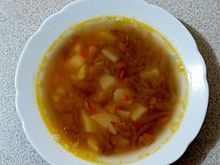Iota (stew)
The jota (also iota , Friulian jote ) is a stew-like soup , which is sometimes also viewed as minestra or maneštra (Mediterranean vegetable soup). It is widespread in numerous variants in the area from Friuli in north-eastern Italy via the Slovenian Karst to Croatian Istria . Almost all variants have a base made from beans, potatoes, smoked meat and, as spices, garlic, bay leaves, salt and pepper. Depending on the region, the main ingredient can be sauerkraut (e.g. in Trieste) or sour beets (e.g. Friuli).
History
The exact origin of the iota is not known and can hardly be discussed in this melting pot of cultures. It is attested, for example, in an old Friulian folk song, a so-called vilotta, which the linguist Jacopo Pirona (1789–1870) recorded towards the end of the 19th century. There it says:
“Simpri jote, simpri jote e mai mai polente e lat; simpri simpri a durmì sole e mai may un biel fantat ”
“Always iota and never polenta and milk; always sleep alone and never a handsome youth. "
Another vilotta that Luigi Garzoni collected in Clavais in the municipality of Ovaro in 1936 strikes a similar note:
“Simpri un vecjo, simpri un vecjo mai une volte un biel fantat
simpri simpri jote frite mai une volte meste e lat”
"Always an old man and not a single time a handsome young man,
always only fried jote and not a single time pulp and milk"
The restaurateur Bepi Pucciarelli told the newspaper Il Friuli that these chants speak for an origin from Friuli, more precisely from Carnia. Pirono was also of this view and explained the term jote as a "Carnic vegetable soup, consisting of brovada, beans, stretched milk and seasoning from butter or bacon, with the addition of corn flour" ( sorta di minestra carnica composta di brovada, fagioli, latte allungato e condimento di burro o lardo, con l'aggiunta di farina gialla ).
Although the iota in Carnia has been documented for a long time, the region is doubted as the place of origin, which is mainly due to the preparation of the Friulian or Carnic iota with brovada: white beets fermented in red wine marc. In this mountain region, however, no viticulture is practiced, but only further down in the valley.
As you can already hear from the two folk songs, the iota has long been considered poor people's food or leftover food in Friuli and is hardly widespread there today. It is also ignored in the recipe collection of the well-known Friulian chef and hotelier Gianni Corsetti (1939–2001).
In Trieste, however, where it is prepared with capuzi garbi , a local variant of sauerkraut, the iota never had this bad reputation and is still widespread today. Some even consider it the flagship of local cuisine. Here, too, there are attempts to explain the origin of the court. The historian, restaurateur and author Cesare Fonda assumes that the iota came about by chance when the capuzi garbi was placed in a tecia (a kind of casserole) with beans that had already been cooked .
variants
Trieste
The Triester Jota ( jota triestina ) consists of potatoes, sauerkraut and smoked pork ribs. It is usually refined with a chopped mixture of bacon, onions, sage and parsley called pestat , which is added to the pot.
Friuli
The Friulian iota ( jote ) contains the so-called brovada instead of sauerkraut . It is a kind of sour beet that does not ferment in lactic acid but in red wine marc . Then they are peeled and cut into fine strips or grated. The local ecotype of the white beet ( Brassica rapa var rapa ), which is appropriately called rapa da brovada and has a characteristic purple root neck, is used for this.
A similar but independent Friulian dish is the mignestre di brovade . Instead of smoked meat, a cooked sausage called muset is served with this, which consists of the minor parts of the bristle animal such as head, rind, trunk and small pieces of muscle and is seasoned with cinnamon, coriander, salt and clove pepper.
Brovade e muset alone, i.e. without jote , is also a typical dish of Friulian cuisine .
Another Friulian variant is iota with chard (for. Jote di bledis , ital. Jota di blede ).
Web links
supporting documents
- ↑ a b c Genuss-Magazin ( Memento of the original from December 17, 2014 in the Internet Archive ) Info: The archive link was inserted automatically and has not yet been checked. Please check the original and archive link according to the instructions and then remove this notice.
- ↑ a b c Jota in the Wibo Wiki (Italian)
- ↑ Maneštre (stew) ( Memento of the original from December 9, 2014 in the Internet Archive ) Info: The archive link has been inserted automatically and has not yet been checked. Please check the original and archive link according to the instructions and then remove this notice.
- ^ Jota: stew from the Karst region at ORF Carinthia
- ↑ La disputa sulla jota. In: Il Friuli . July 11, 2006.
- ↑ Brovade e muset (description and recipe) at Cookaround (Italian)
